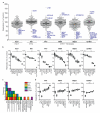A diverse range of gene products are effectors of the type I interferon antiviral response
- PMID: 21478870
- PMCID: PMC3409588
- DOI: 10.1038/nature09907
A diverse range of gene products are effectors of the type I interferon antiviral response
Erratum in
-
Corrigendum: A diverse range of gene products are effectors of the type I interferon antiviral response.Nature. 2015 Sep 3;525(7567):144. doi: 10.1038/nature14554. Epub 2015 Jul 8. Nature. 2015. PMID: 26153858 No abstract available.
Abstract
The type I interferon response protects cells against invading viral pathogens. The cellular factors that mediate this defence are the products of interferon-stimulated genes (ISGs). Although hundreds of ISGs have been identified since their discovery more than 25 years ago, only a few have been characterized with respect to antiviral activity. For most ISG products, little is known about their antiviral potential, their target specificity and their mechanisms of action. Using an overexpression screening approach, here we show that different viruses are targeted by unique sets of ISGs. We find that each viral species is susceptible to multiple antiviral genes, which together encompass a range of inhibitory activities. To conduct the screen, more than 380 human ISGs were tested for their ability to inhibit the replication of several important human and animal viruses, including hepatitis C virus, yellow fever virus, West Nile virus, chikungunya virus, Venezuelan equine encephalitis virus and human immunodeficiency virus type-1. Broadly acting effectors included IRF1, C6orf150 (also known as MB21D1), HPSE, RIG-I (also known as DDX58), MDA5 (also known as IFIH1) and IFITM3, whereas more targeted antiviral specificity was observed with DDX60, IFI44L, IFI6, IFITM2, MAP3K14, MOV10, NAMPT (also known as PBEF1), OASL, RTP4, TREX1 and UNC84B (also known as SUN2). Combined expression of pairs of ISGs showed additive antiviral effects similar to those of moderate type I interferon doses. Mechanistic studies uncovered a common theme of translational inhibition for numerous effectors. Several ISGs, including ADAR, FAM46C, LY6E and MCOLN2, enhanced the replication of certain viruses, highlighting another layer of complexity in the highly pleiotropic type I interferon system.
Figures




Comment in
-
A dive into the complexity of type I interferon antiviral functions.J Hepatol. 2012 Mar;56(3):726-8. doi: 10.1016/j.jhep.2011.07.009. Epub 2011 Jul 27. J Hepatol. 2012. PMID: 21801700 No abstract available.
-
Large-scale identification of effector genes that mediate the type I interferon antiviral response.Gastroenterology. 2012 Jan;142(1):178-80. doi: 10.1053/j.gastro.2011.11.008. Epub 2011 Nov 19. Gastroenterology. 2012. PMID: 22107719 No abstract available.
References
References for Print Article
-
- de Veer MJ, et al. Functional classification of interferon-stimulated genes identified using microarrays. J Leukoc Biol. 2001;69:912–920. - PubMed
-
- Dupuis S, et al. Impaired response to interferon-alpha/beta and lethal viral disease in human STAT1 deficiency. Nat Genet. 2003;33:388–391. - PubMed
-
- Keskinen P, et al. Impaired antiviral response in human hepatoma cells. Virology. 1999;263:364–375. - PubMed
References for Supplemental Information
-
- Tsetsarkin K, et al. Infectious clones of Chikungunya virus (La Reunion isolate) for vector competence studies. Vector Borne Zoonotic Dis. 2006;6:325–337. - PubMed
Publication types
MeSH terms
Substances
Associated data
- Actions
Grants and funding
LinkOut - more resources
Full Text Sources
Other Literature Sources
Medical
Molecular Biology Databases
Research Materials
Miscellaneous

